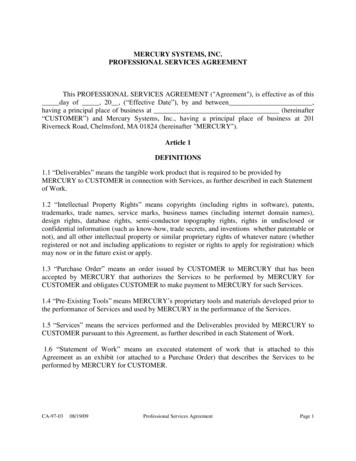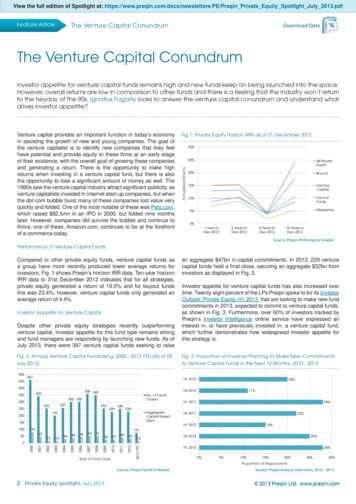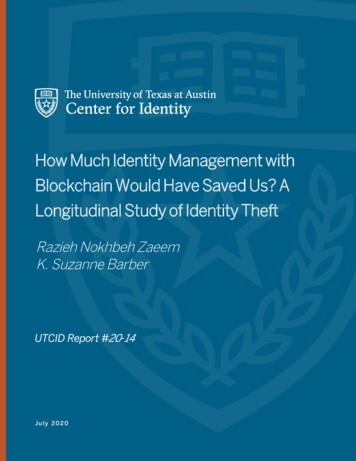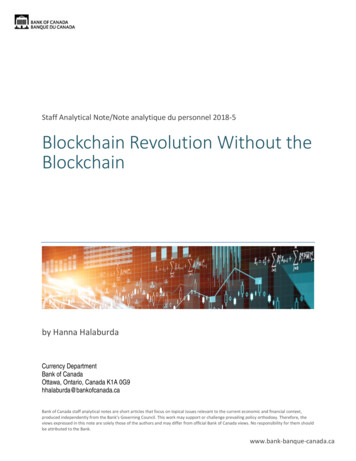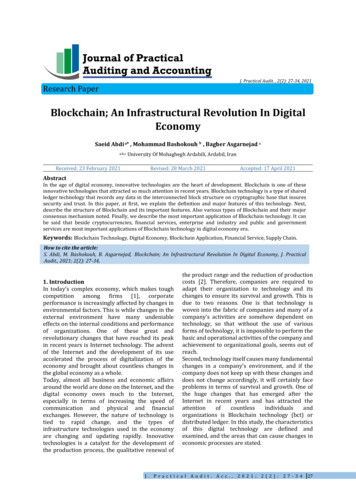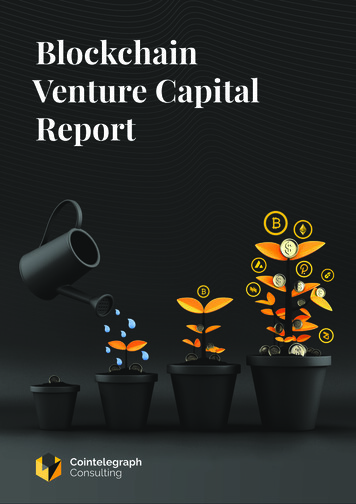
Transcription
BlockchainVenture CapitalReport
Research PartnersWe thank our research partners for their support of this reportAuthorsDemelza HaysDmitry ElkovDemelza Hays is theDmitry Elkovdirector of researchis an analyst at Helen RosenbergNatalie MalkhasyanIgor Kravchenkoat Cointelegraph,telegraph and hasis a research analystis a senior researchis a research analystformer Forbesover five yearsat Cointelegraph,analyst at Cointele-at Cointelegraph.30 Under 30, U.S.of experience in tra-holds a bachelors’graph, has over sixHe is currently pur-Department of Stateditional and cryptodegree in economicsyears of experiencesuing a master’s de-Fulbright Scholarcorporate finance.and finance and hasin strategic consult-gree in quantitativeco-authored threeing at Big Three andfinance at the Viennaof two regulatedreports at Cointele-Big Four companies.University of Eco-crypto funds.graph Research.and fund managerCointelegraph Consulting Venture Capital Report nomics and Finance.2
ContentsSection 1: The Financial Landscape 1.1 The Stakeholders 581.2 2020’s Largest Blockchain VC Deals 101.3 North America is Still the Leading Blockchain VC 111.4 COVID-19’s Toll on Blockchain Private Equity 121.5 Evolution of the Economy 131.6 Where Venture Capital Is Forecasted to Flow in 2021 14Section 2: Startups 172.1 Types of Private Equity Investors 172.2 From the Startup’s Perspective: Using Tokens to Raise Capital 212.2.1 Token Fundraising Options 212.2.2 Token Sale Advantages 222.2.3 Token Sale Downsides 252.3 Determinants of Fundraising Success 262.4 Venture Capitalists Are Funding Decentralized Technologies 292.4.1 Most Popular DeFi Companies For VCs 312.4.2 DeFi VC in 2021 and Beyond 33Section 3: Limited Partners 353.1 Blockchain VC Investment Thesis 353.1.1 Buying Digital Assets Directly 363.1.2 Buying Security Tokens 373.1.3 Buying VC funds 383.2 Do Asian Blockchain Companies Offer Higher Returns with Lower Risk? 413.3 Venture Capital Taxes for Investors 43Section 4: General Partners 464.1 Valuation Methods for Blockchain Companies 464.2 Regulation on VC Funds 504.3 From the Sell side’s Perspective: Tokenizing a Fund 524.4 The Exit Strategies 55Section 5: Conclusion Cointelegraph Consulting Venture Capital Report 593
Highlights8 There are very few blockchain VC funds for retail in-vestors, even though there is high demand. A possibleworkaround to regulations that stop retailers from investing in blockchain VC funds is to mimic the coin/token holdings of professional investors. Similar to copying Berkshire Hathaway’s trades, investors can watchwhat investments blockchain VC funds make and thenadd tokens to their own privately managed portfolioif the blockchain company has a token. For example,Messari tracks Polychain’s portfolio containing Bitcoin(BTC), Ether (ETH), Polkadot (DOT), Tezos (XTZ), Filecoin (FIL), Cosmos (ATOM), Yearn.finance’s YFI, Maker(MKR), Compound’s COMP, Zilliqa (ZIL), 0x (ZRK), Celo,Orchid (OXT), Avalanche (AVAX) and Nervos Network(CKB).1 You can also see Digital Currency Group’s tokenholdings here: https://dcg.co/portfolio/.8Dedicated blockchain VC funds have significantlyoutperformed the market and regular VC funds overthe past seven years. While traditional funds have theirRate of Return in the low double digits, several blockchain venture capital funds have managed to matchthose returns 10 times over including BlockchainCapital and CoinFund. As the market matures, thosereturns are likely to taper off, however, we are still veryearly. Blockchain venture capital amounts to less than1% of the entire VC market.8Blockchain venture capital funds exhibit low correlation with traditional markets, which is a sought-afterquality for alternative asset classes. For the most part,correlations between blockchain VC and stocks, bonds,and commodities have been in the 0.00 – 0.14 range.Although VC funds normally have a quarterly netasset value, or NAV, the tradable shares of BlockchainCapital’s third fund, Fund III, have a weekly NAV. Whencomparing the correlations of the weekly log-returnsof the fund since inception in April 2017 to December2020, the diversification potential for investors interested in venture capital is loud and clear.8VC investments in the blockchain industry are underserious economic pressure from COVID-19. BlockchainVC investments decreased by 13% between 2019 and2020, while traditional VC investment increased by 18%.The total amount invested in blockchain VC droppedfrom 3.17 billion in 2019 to 2.77 billion in 2020.8Decentralized Finance was the 2020 hot trend in blockchain Venture Capital (and more particularly, DeFion Ethereum, since over 90% of the total value lockedin those protocols resides there). Out of 676 registeredblockchain VC deals in 2020, over 100 of the projectswere related to DeFi.18 The Asian blockchain VC market may be the equiva-lent of emerging market stocks. While Asia is currentlyin the third position in terms of blockchain VC investment at 25.08% compared to 56.29% in NorthAmerica, the trend may be reversing. Mass adoptionof blockchain networks may happen in Asia faster thanin the rest of the world because of the sheer number of possible users. For example, Klaytn and Link(by Line) already have 50 million and 165 million users,respectively, while Facebook’s Diem, formerly referredto as Libra, and Telegram’s TON have been stoppedby regulators in the West. Nervos Network is one of thedarling investments stemming from Asia that is heldby several blockchain VCs.8For firms that are in their Series A funding round andbeyond, price to sales (P/S), price to book (P/B) andprice to earnings per share (P/E) are common comparative analysis multiples used to value blockchainprivate equity. The valuations of some private cryptocompanies are astronomically higher than the FANGstocks. For example, one crypto company raised capital with a P/E ratio of 110. To put this into comparison,Apple’s P/E ratio after the coronavirus was hoveringaround 24 but reached a maximum of 41.93 in December 2020. However, this is comparing apples to oranges to some degree.8 Tokenizing a VC fund is similar to equity crowdfund-ing, a growing industry that emerged after deregulation of the sector by the 2012 Jobs Act in the UnitedStates and similar acts in Europe and Asia. In a typicalVC structure, it is challenging for both Limited Partners and General Partners to exit their investmentsas they are locked in for five to seven years. Tokenizinga VC fund and investing in tokenized equity enablesLPs, GPs, and other qualified investors to exit theirinvestment faster by liquidating it on the secondarymarket if the contract with the startup allows early exit.8While historically, most of the investments in the cryptospace happened with little to no VC involvement (82%of all investments to date), 2020 saw a significant shiftin those numbers. Last year, only 22% of investmentshad no VC involvement at all, and the remaining 78%were equally split between crypto VC firms, regularVC firms and joint ventures between the two. Themajority of those investments happened at the seedround (which also offers the highest potential returns)and were focused toward blockchain in-capital-portfolio-6E2FF33BCointelegraph Consulting Venture Capital Report 4
The Financial LandscapeWelcome to the Blockchain Venture Capital Reportment of the global private equity market for one simpleby Cointelegraph Research. In five chapters and overreason: outsized return. In the dataset prepared for75 pages, this report highlights key trends in the block-this report, we discovered that 942 venture capital-chain private equity market.ists have invested in over 2,700 private equity dealsinvolving startups and companies in the blockchainGlobal private equity investments are a key driverof innovation, job creation and economic growth because they put dormant capital and expertise towardresearch, development and innovation. Blockchainventure capital has been an increasing important seg-space since 2012.2 The proof is in the numbers. Notonly has the crème de la crème of blockchain VC fundsconsistently outperformed traditional VC funds, thetop blockchain VC funds have also outperformed thetechnology sector as a whole.Figure 1Blockchain Private Equity Has Outperformed Traditional Private EquitySince Inception of the Fund IRR 2013 – %10%4%Fund II50%Fund I111% 5% 25%201520162017CA US Private Equity IndexCA US Venture Capital IndexBlockchain CapitalCoinFund Fund2018CA Ex-US PE & VC IndexSource: Cambridge Associates LLC 3, Blockchain Capital LLC 4, CoinFund LLC 5, Cointelegraph Research2Contact research@cointelegraph.com to gain access to the dataset3As of June 30, 2020, based on data compiled from 1,529 U.S. venture capital funds, including fully liquidated partnerships, formed between 1995 and2018, internal rates of returns are net of fees, expenses and carried WEB-2020-Q2-ExUS-Dev-EM-Selected-Book.pdf4As of Dec. 31, 2020. Blockchain Capital LLC’s net IRR figures account for performance and management fees5As of Dec. 31, 2020. CoinFund LLC’s net IRR figures account for performance and management feesCointelegraph Consulting Venture Capital Report 5
Figure 2Blockchain Private Equity Has Outperformed TraditionalPrivate Equity Across 1-, 3-, and 5-Year Horizons79%80%65%60%62%40%26%20%20%13%19% 17%16%21%15% 16%18%12% 12%8.3%0.4%1.9%0%CA US VentureCapital IndexCA US PrivateEquity IndexCA Ex-USDeveloped MarketsPrivate Equity & VCCA EmperingMarkets PrivateEquity & VCSource: Cambridge Associates LLC 6, Blockchain Capital LLC, CoinFund LLC, Cointelegraph ResearchAn increasing number of traditional venture capitalRussell 2000 IndexBlockchain CapitalFund I1-Year2-Year3-Yearof blockchain venture capital may be one explanationfirms are investing into this space; however, block-for its slow but steady growth in market share over thechain private equity still amounts for less than 1%past decade.of the global venture capital market. This signalsthe high level of risk associated with blockchain privateequity, but this also signals just how early we all arein this space and that there is still room for significantgrowth in the future. During the 2017 crypto bull run,blockchain venture capital almost reached 2% of theVC market. We suspect 2021 may be similar dueto market momentum surrounding the Bitcoin halvingand the stimulus action of governments.In comparison with the trajectory of “internet-specif-There might be a few other reasons why blockchainVC is attracting so much attention from limited partners and buy-side investors. In addition to the returnrewarding early movers, the return has been uncorrelated with traditional asset classes. To calculate logreturn correlations, we took the weekly net asset valueof the tokenized shares of Blockchain Capital’s thirdfund, Fund III.8 When comparing the correlations of theweekly log returns of the fund since inception in April2017 to December 2020, the diversification potentialic” VC investments, this puts the blockchain industryfor investors interested in venture capital is loudin a period similar to the early 1990s, about a decadeand clear. Blockchain private equity appears to havebefore the dot-com bubble. Between 1990 and 1994,the highest correlation with hedge fund returns in theinternet-related deal flow grew from 0% to 5%, peakedUS; however, even that correlation is low. Similar to tra-at over 45% in 2000 and has since corrected to a sta-ditional private equity, blockchain private equity alsoble 10% – 20%.7 Similar to cryptocurrencies and otherhas the potential to weather bad storms. In 2018,digital assets, private equity is considered to be an al-when the crypto market was tanking along with cryptoternative asset class compared to traditional assetfunds, BCAP tokens returned 264%.classes, such as stocks and bonds. The exotic nature6As of Sept. 30, 2020. The index is a horizon calculation based on data compiled from 1,980 U.S. venture capital funds, including fully liquidated partnerships, formed between 1981 and 2020. The calculations for the CA U.S. Venture Capital Index, CA U.S. Private Equity Index, CA EX U.S. DevelopedMarkets Private Equity & VC, and CA Emerging Markets Private Equity & VC are pooled horizon return, net of fees, expenses, and carried interest. Thecalculation for the Russell 2000 horizon is CA’s Modified Public Market Equivalent (mPME), which replicates private investment performance underpublic market conditions. The public index’s shares are purchased and sold according to the private fund cash flow schedule, with distributions calculated in the same proportion as the private fund, and mPME NAV is a function of mPME cash flows and public index returns. Refer to the methodology page of each CA report linked below for al/weekly-nav/Cointelegraph Consulting Venture Capital Report 6
Figure 3Blockchain VC Still Makes Up Less Than 1% of Global VC Market2.0%1.8% 300B1.6% 250B1.4%1.2% 200B1.0% 150B0.8%0.6% 100B0.4% 50B0.2% 0BMarkets Share of Blockchain Private EquityTotal Invested Per Year Globally 350B0%20122013201420152016Source: Crunchbase News 9, Blockchain Capital, Cointelegraph Research20172018Traditional VCs20192020Blockchain VCMarket ShareBlockchain Private Equity Is Uncorrelated TraditionalPrivate Equity, Stocks and CommoditiesLog returnNAV BCAPHorizons MorningstarHedge Fund IndexBloomberg BarclaysHigh Yield Bond ETFMSCI EmergingMarket IndexNAV BCAP1Horizons MorningstarHedge Fund Index0.1973409471Bloomberg BarclaysHigh Yield Bond ETF0.1625623510.5333138031MSCI Emerging Market Index0.2385012150.6149860540.6123660461S&P 5000.1954247670.774332410.8180200260.776651227S&P 5001Source: Data covers the period from June 17, 2017 – December 31, 2020. Yahoo Finance, Blockchain Capital LLC, Cointelegraph ResearchFinally, the allure of increased liquidity has also beenwith blockchain technology. Therefore, if small firmstouted as a potential driver for the increasing de-tokenize their private equity, then investors wouldmand for blockchain private equity. The theory goeshypothetically be able to open and close positions a lotsomething like this: If tokenizing assets lowers theeasier than in the current VC model involving 10-yearcost of raising capital, then small and medium-sizedlock up periods. However, there are caveats to thisenterprises that are too small to go public on a tra-potential benefit, and we discuss them in Chapter 4.3.ditional stock market will now be able to raise ws/global-2020-funding-and-exit/Cointelegraph Consulting Venture Capital Report 7
Figure 4One Year Rolling Correlation of Blockchain Capital’s BCAP Token’s Weekly Log Returns0.4Correlation Coefficient0.30.20.10 0.1 0.2 0.3Jan ‘20Feb ‘20Mar ‘20Apr ‘20May ‘20Jun ‘20Jul ‘20Aug ‘20Sep ‘20Oct ‘20Nov ‘20Dec ‘201-year correlation Nv BCAP — MSCI Emerging Market Index1-year correlation Nv BCAP — Bloomberg Barclays High Yield Bond1-year correlation Nv BCAP — S&P 5001-year correlation Nv BCAP — Horizons Morningstar Hedge FundSource: Data covers the period from December 18, 2018 – December 31, 2020. Yahoo Finance, Blockchain Capital LLC, Cointelegraph ResearchLearn VC: Limited PartnerLimited partners (LPs) are investors that buy shares of VC funds that invest capital in the private equityof startups and companies.1.1The StakeholdersThis overview highlights the ecosystem’s investmentThe blockchain VC ecosysteminvolves 3 main partiespatterns over the past decade, top performers, investors, locations and industries, and most importantlyEntrepreneurstries to answer why these charts look the way they do.who need funding tofinance their businessThe financial landscape of blockchain venture capitalinvolves three main stakeholders, entrepreneurs, private investors and venture capital. Being a subcategoryof the global VC industry, blockchain VC shares manysimilarities but also introduces a host of new risksand opportunities.Blockchain impacts three key areas of the venturecapital industry, including how startups raise capital,how buy-side investors can diversify their portfolios,and how sell-side asset management companies cangenerate new streams of revenue.Cointelegraph Consulting Venture Capital Report Private investorswho seek high returns for thecapital they are providingVenture capitalistssources start-ups with high potentialand provides mentorship to enhancesuccess rate8
Learn VC: General PartnerA venture capitalist, also referred to as a general partner (GP), is a financial intermediary that matches theLP’s capital with private companies seeking funding.Blockchain Technology Disrupts the VC IndustryStartupsBuy-Side Investors (LPs)Sell-Side Investors (GPs)Larger Pool of Investors: Startups can selltokens online to a global pool of both retailand accredited investors instead of onlyto accredited investors.Investment Opportunities: Distributedledger technologies offer new investmentopportunities to investors. Traditional VCsare gradually diversifying their portfoliosto invest in crypto assets and blockchaintechnology projects.New Revenue Streams: On the sell side, VCsare launching crypto-centric private equityfunds and fund of funds (FOF).Lower Costs: By removing intermediariessuch as underwriters and contract lawyers,startups can save money and speed up theprocess.Exiting Positions: By tokenizing positionsin early-stage and growth-stage venturecapital investments, limited partners canexit their positions before the companygoes to IPO or is acquired if the originalcontract with the startup allows early exits.Blockchain enables trading of this once upona time illiquid investment by tokenizing theinvestor’s rights.Inclusive and Transparent Funding: Severalblockchain VC funds have claimed ownershipof their Ethereum wallet address, therebyenabling the whole world to watch the investments they make in real time.Rebalancing Made Easier: Adjustment of positions can be done by trading the tokenizedequity of the companies they are investedin that form the underlying assets for thefund. Tokenized VC funds also enable GPsto buy back tokens from investors off of theopen market similar to a share buy-back.Source: Cointelegraph ResearchThe remaining sections in the report targetVC and summarize the regulations and taxes thateach shareholder.impact investors in select locations.Section 2 focuses on entrepreneurs who are inter-Finally, Section 4 is for the VCs themselves. In thisested in raising capital for their blockchain startupchapter, we discuss the ins and outs of tokenizingor company. We explore the factors that impact howa fund and exit strategies for blockchain startups thatmuch a startup raises and discuss key questions, suchare nonprofits or decentralized. We also cover strat-as how VCs view startups that have done initial coinegies for valuing blockchain startups and explain whyofferings or token sales in the past.some are better suited for this industry than others.Section 3 targets private investors from the traditionalThe report concludes with our outlook for blockchainfinance realm that are curious about blockchain andventure capital in 2021, including non fungible tokenscryptocurrencies. We compare the average returnsand the proliferation of decentralized finance.and lockup periods for traditional vs. blockchainCointelegraph Consulting Venture Capital Report 9
1.22020’s Largest Blockchain VC DealsIn the U.S., three companies stole the show: Bakkt, Paxos, and Chainalysis. Together, they accounted for 42% of the total moneyraised by companies in the U.S. and for 21% of the global blockchain private equity market. They attracted 542 million.Top 5 companies in blockchain industry by money raised in 2020 300MIn 2020 142MIn 2020 113MIn 2020 60MTotal 240MTotal 167MTotal 158,7M 482,5MIn 2020TotalBlockFi is a digital platform 62M 66,4MIn 2020TotalBakkt is a financial servicesPaxos is a financial technologyChainalysis is a blockchainBitso is a Bitcoin exchangecompany which focusescompany that deliversanalysis firm whichthat provides crypto savingsthat is pioneering in Mexicanon digital currency andblockchain solutions for globalprovides data and analyticsaccounts and crypto-backedmarket. It offers a digitalspecializes in concurrency,financial institutions. The mainto government agencies,loans in addition to supportingplatform for trading Bitcoinrewards, and loyalty.product is Bankchain, a cloud-exchanges, and financialcrypto trading. A securedwith Mexican Peso. TheBakkt has raised overbased platform as a serviceinstitutions. During 2020 thenon-bank lender, it offerscompany has raised 482.5 million, 182.5 million(PaaS) blockchain settlementcompany raised 113 millionUSD loans to crypto-asset 66.4 million in funding,in Series A in 2018 andsolution for capital markets.in Series B and Series C. Totalowners which collateralize 1.9 million in seed round and 300 million in 2020. In 2020The main product is Bankchain,money raised is 167 million,the loan with their crypto- 2.5million in Series A in 2016,cryptocurrency derivativesa cloud-based platform 1.6 million in seed roundassets. Their products deliver 62 million in Series B in 2020.exchange Bakkt partneredas a service (PaaS) blockchainin 2016, 16 million in Seriesadditional liquidity to thewith Starbucks to offersettlement solution for capitalA in 2018, 30 million in Seriesblockchain asset sector anda new payment opportunitymarkets. With the funding,B in 2019. Chainalysis is valuedsatisfy the needs of individualsfor Starbucks applicationPaxos will continue investingat 1 billion which is quite rareand organizations that holdusers. In the near future thein developing corporatefor a blockchain data analyticsblockchain assets.service firm.Starbucks mobile app will offerinfrastructure solutions“Bakkt Cash” as an alternativewhile improving security,payment solution.regulation, reliability.Cointelegraph Consulting Venture Capital Report 10
North America is Still theLeading Blockchain VCBlockchain companies from North America,In 2020, North America led the way in the averageAsia, and Europe have led funding for the lastamount of money raised per deal ( 8.3 million) fol-eight years. Investors put more than 2.75 billionlowed by Asia (5.9 million) and Europe ( 4.4 million).in 622 blockchain deals in 2020, doubling 2017’s num-Although Asia’s major economies recovered frombers of 1.28 billion USD across 322 deals, but fargovernment imposed economic shutdowns morebehind 2018’s impressive 7.75 billion USD acrossrapidly than the rest of the world, the fastest rebound833 deals. To put things into perspective, block-in dealflow following COVID-19 was Europe.chain-related deals made up 0.92% of all VC dealsAt the country level, the United States, United Kingdomin 2020. This is down from 1.25% in 2019, and 1.87%and China account for 68% of the capital raised be-in 2018.tween 2012 – 2020. Other countries with a significantshare are Switzerland with 5% and Singapore with 3%.Figure 5North America, Asia, and Europe Have the Most Blockchain VC Deals (2012 – 2020) 10B1400 9B1200 8B1000 7B 6B800 5B600 4B 3B400Total Amount RaisedNumber of Deals1.3 2B200 1B0 0AfricaAsiaEuropeNorth AmericaOceaniaSource: Cointelegraph ResearchSouth AmericaNumber of DealsTotal Amount RaisedFigure 6North America, Asia, and Europe Have the Most Blockchain VC Deals 3.0B 2.48 2.5B 2.03 2.0B 1.94 1.5B 1.16 0.88 1.0B 0.5B 020122013Source: Cointelegraph Research20142015North AmericaCointelegraph Consulting Venture Capital Report 2016Asia2017Europe2018Africa 0.54 0.44 0.33 0.5220192020South AmericaOceania11
Figure 7Capital Raised by Blockchain Companies by Country of Company Headquarters 2,500 2,000 1,500 1,000 500 02012201320142015Source: Cointelegraph eUKCOVID-19’s Toll on BlockchainPrivate EquityOverall, blockchain VC investments decreasedcautious to invest further resources in blockchainby 13% between 2019 and 2020, while traditionalcompanies. Although the number of deals decreasedVC investment increased by 18%. This is a perplexingfrom a maximum of 661 in 2018 to 423 in 2019 (a 36%result. We can only explain this result as a responsedrop), the number of deals rebounded by 25% in 2020,to the 2018 and 2019 downturn in the digital assetup to 609. The higher number of deals and lower totalmarket, while traditional stock markets continuedcapital raised reduced the average blockchain dealto perform well. This may have made some investorsfrom 7.1 million in 2019 to 4.2 million in 2020.Figure 8Blockchain Private Equity Funding Per Year and Number of Deals800 7B700678600Number of Deals1.42016 6B 5B500 4B400 2.78300 3B 2B200 1B1000 02012201320142015Source: Cointelegraph ResearchCointelegraph Consulting Venture Capital Report 2016201720182019Blockchain Private2020Equity Funding12
COVID-19 wrecked two quarters of blockchain VC in-Overall, we expect both the number of deals and thevestment across the globe, but Q4 2020 saw a strongamount of capital invested in blockchain companiesrecovery. In Q4 2020, the amount of money raisedto increase in 2021 due to macroeconomic conditions,increased 37% in comparison to Q3 2020. This positivesuch as increased government stimulus and microeco-trend indicates a possible recovery in VC investmentsnomic conditions, for example, the market’s responsein the near future.to Bitcoin’s 2020 reduction in block rewards.Figure 9Global Capital Raised by Blockchain Companies in 2020 in Millions 845.29 763.33 770.70 762.93 756.30 652.64Q1Q2Q3Q4Q12019 561.20 549.14Q2Q3Q42020Source: Cointelegraph Research1.5Evolution of the EconomyOver the past few decades, we have seen a gradualIn the examples above, we still have a mostly central-shift from fully centralized economies to platformized model where the success of the venture dependseconomies. This process is characterized by the reali-on a single entity: the company acting as an interme-zation of large companies that they cannot effectivelydiary in the process. In a decentralized protocol-basedcompete with crowd-sourced contributions. Someeconomy, the protocol is the intermediary and the pro-examples of this are social networks, such as Facebooktocol itself is maintained by community contributors.or YouTube, where content is exclusively producedThere can still be centralized services offering interfac-by the platform users (both with and without externales to the protocol, but the success of the protocol itselfincentives). Similar examples are Airbnb and Uber,no longer relies on any individual company.where the company does not possess the infrastructure for the offered services but, rather, just facilitatestransactions via its platform.Learn VC: Protocol Economy#Hashed VC has coined the term “Protocol Economy” to refer to the process of removing unnecessary intermediaries and their associated costs by directly connecting contributors with consumers.Cointelegraph Consulting Venture Capital Report 13
Economic Model Evolution1850Future1850 – Mid 1990DescriptionValueDataMid 1990 – PresentFutureCentralized EconomyPlatform EconomyProtocol EconomyCorporate ModelMarketplace ModelPermissionless ModelEmployees within companiesprovide goods and servicesEmployees and contributorsform outside companiesgenerate valueAny and all participants areenabled and incentivizedto contributeShareholder ValueShareholder ValueCommunity ValueCorporates focus on growthand wealth generation forshareholdersMarkets generate value forstakeholders, i.e. contributorsand end consumersNetworks, with internal focus,provides value to all contributors and usersLow Data SophisticationIncreasing Data UsageData SovereightyLack of infrastructure andtechnology for proper datausage and analyticsIndustry, market, andconsumer data are usedto enhance operationsData is key to the economy,and is hence prioritized andprotectedExamplesSource: #Hashed VC1.6Where Venture Capital IsForecasted to Flow in 2021With the fundamental blockchain infrastructureWith the growth of the space, we are also seeingalready built, we expect upcoming venture capitalan increase in mergers and acquisitions as opposedto focus on higher layers of the tech stack: (1) func-to traditional ways of fundraising. Since the infrastruc-tionality and (2) apps. For example, if TCP/IP and HTTPture around cryptocurrencies is starting to mature,are the foundational protocols for the internet, Ethere-while the overall complexity remains high and talentum and other smart contract platforms are becomingis scarce, it often makes more sense to acquire ratherthe foundational infrastructure layer on top of whichthan to build from the ground-up. Acquisitions happenvarious blockchain applications are built.both within the space (crypto companies acquiringAs each layer develops, it becomes the foundation forthe next one. The currently thriving world of decentralized finance would not have been possible withoutEthereum as a base layer. For example, Aave, withcrypto companies) and outside of it (crypto companiesacquiring non-crypto companies and vice versa). Someprominent examples in this regard
Blockchain Capital LLC's net IRR figures account for performance and management fees 5 As of Dec. 31, 2020. CoinFund LLC's net IRR figures account for performance and management fees . Blockchain Capital CoinFund Fund CA US Private Equity Index CA US Venture Capital Index CA Ex-US PE & VC Index 2015 12% 18% 2503% Fund I 2018 14% 11% 5% .


